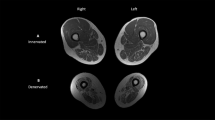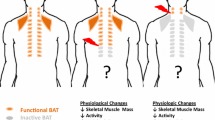Abstract
Purpose
Changes in metabolism and body composition after spinal cord injury (SCI) predispose individuals to obesity, type II diabetes, and cardiovascular disease. A link between lean mass and skeletal muscle mitochondrial mass has been reported but it is unknown how skeletal muscle mitochondrial mass and activity impact metabolic health. This study examined the relationship between skeletal muscle mitochondrial mass, activity and metabolic profile in individuals with chronic SCI.
Methods
Twenty-two men with motor complete SCI participated in the study. Citrate synthase (CS) and complex III (CIII) activity was measured in vastus lateralis biopsies. Metabolic profile was assessed by intravenous glucose tolerance test, basal metabolic rate (BMR), maximum oxygen uptake (VO2 peak) and blood lipid profile.
Results
Skeletal muscle CS activity was negatively related to the cholesterol:high density lipoprotein cholesterol (HDL-C) ratio and triglycerides (r = −0.60, p = 0.009; r = −0.64, p = 0.004, respectively). CS activity was positively related to insulin sensitivity and BMR (r = 0.67, p = 0.006; r = 0.64, p = 0.005, respectively). Similar relationships were found for CIII and metabolic profile, but not CIII normalized to CS. Many of the relationships between CS and metabolism remained significant when age, level of injury, or time since injury were accounted for. They also remained significant when CS activity was normalized to total lean mass.
Conclusions
These results suggest that an increase in skeletal muscle mitochondrial mass is associated with improved metabolic health independent of age, level of injury, or time since injury in individuals with chronic SCI. This highlights the importance of maintaining and improving mitochondrial health in individuals with SCI.




Similar content being viewed by others
Abbreviations
- ASIA:
-
American spinal injury association
- BMR:
-
Basal metabolic rate
- CIII:
-
Complex III
- CS:
-
Citrate synthase
- DXA:
-
Dual-energy X-ray absorptiometry
- FFA:
-
Free fatty acids
- HbA1c:
-
Glycated hemoglobin
- HDL-C:
-
High-density lipoprotein cholesterol
- LDL-C:
-
Low-density lipoprotein cholesterol
- LOI:
-
Level of injury
- PGC-1α:
-
Peroxisome-proliferator-activated receptor-gamma co-activator 1alpha
- SCI:
-
Spinal cord injury
- S i :
-
Insulin sensitivity
- S g :
-
Glucose effectiveness
- TG:
-
Triglycerides
- TSI:
-
Time since injury
- VO2 peak:
-
Maximum oxygen uptake
References
Antoun G et al (2015) Impaired mitochondrial oxidative phosphorylation and supercomplex assembly in rectus abdominis muscle of diabetic obese individuals. Diabetologia 58:2861–2866. doi:10.1007/s00125-015-3772-8
Bauman WA, Spungen AM (1994) Disorders of carbohydrate and lipid metabolism in veterans with paraplegia or quadriplegia: a model of premature aging. Metabolism 43:749–756
Bauman WA, Spungen AM (2001) Carbohydrate and lipid metabolism in chronic spinal cord injury. J Spinal Cord Med 24:266–277
Bauman WA, Spungen AM, Zhong YG, Rothstein JL, Petry C, Gordon SK (1992) Depressed serum high density lipoprotein cholesterol levels in veterans with spinal cord injury. Paraplegia 30:697–703. doi:10.1038/sc.1992.136
Bharadwaj MS, Tyrrell DJ, Lyles MF, Demons JL, Rogers GW, Molina AJ (2015) Preparation and respirometric assessment of mitochondria isolated from skeletal muscle tissue obtained by percutaneous needle biopsy. J Vis Exp. doi:10.3791/52350
Boston RC, Stefanovski D, Moate PJ, Sumner AE, Watanabe RM, Bergman RN (2003) MINMOD Millennium: a computer program to calculate glucose effectiveness and insulin sensitivity from the frequently sampled intravenous glucose tolerance test. Diabetes Technol Ther 5:1003–1015. doi:10.1089/152091503322641060
Brass EP, Hiatt WR, Gardner AW, Hoppel CL (2001) Decreased NADH dehydrogenase and ubiquinol-cytochrome c oxidoreductase in peripheral arterial disease. Am J Physiol Heart Circ Physiol 280:H603–H609
Brown MS, Goldstein JL (1984) How LDL receptors influence cholesterol and atherosclerosis. Sci Am 251:58–66
Buchholz AC, McGillivray CF, Pencharz PB (2003) Differences in resting metabolic rate between paraplegic and able-bodied subjects are explained by differences in body composition. Am J Clin Nutr 77:371–378
Carter HN, Chen CC, Hood DA (2015) Mitochondria, muscle health, and exercise with advancing age. Physiology (Bethesda) 30:208–223. doi:10.1152/physiol.00039.2014
Castro MJ, Apple DF Jr, Staron RS, Campos GE, Dudley GA (1999) Influence of complete spinal cord injury on skeletal muscle within 6 mo of injury. J Appl Physiol (1985) 86:350–358
Chilibeck PD et al (1999) Functional electrical stimulation exercise increases GLUT-1 and GLUT-4 in paralyzed skeletal muscle. Metabolism 48:1409–1413
Chomentowski P, Coen PM, Radikova Z, Goodpaster BH, Toledo FG (2011) Skeletal muscle mitochondria in insulin resistance: differences in intermyofibrillar versus subsarcolemmal subpopulations and relationship to metabolic flexibility. J Clin Endocrinol Metab 96:494–503. doi:10.1210/jc.2010-0822
DeFronzo RA, Jacot E, Jequier E, Maeder E, Wahren J, Felber JP (1981) The effect of insulin on the disposal of intravenous glucose. Results from indirect calorimetry and hepatic and femoral venous catheterization. Diabetes 30:1000–1007
Distefano G et al (2016) Chronological age does not influence ex-vivo mitochondrial respiration and quality control in skeletal muscle. J Gerontol A Biol Sci Med Sci. doi:10.1093/gerona/glw102
Duckworth WC, Solomon SS, Jallepalli P, Heckemeyer C, Finnern J, Powers A (1980) Glucose intolerance due to insulin resistance in patients with spinal cord injuries. Diabetes 29:906–910
Essén B, Jansson E, Henriksson J, Taylor AW, Saltin B (1975) Metabolic characteristics of fibre types in human skeletal muscle. Acta Physiol Scand 95(2):153–165
Essén-Gustavsson B, Henriksson J (1984) Enzyme levels in pools of microdissected human muscle fibers of identified type. Adaptive response to exercise. Acta Physiol Scand 120(4):505–515
Gorgey AS, Dudley GA (2007) Skeletal muscle atrophy and increased intramuscular fat after incomplete spinal cord injury. Spinal Cord 45:304–309. doi:10.1038/sj.sc.3101968
Gorgey AS, Gater DR (2011) Regional and relative adiposity patterns in relation to carbohydrate and lipid metabolism in men with spinal cord injury. Appl Physiol Nutr Metab 36(1):107–114
Gorgey AS, Lawrence J (2016) Acute responses of functional electrical stimulation cycling on the ventilation-to-CO2 production ratio and substrate utilization after spinal cord injury. PMR 8(3):225–234
Gorgey AS, Chiodo AE, Zemper ED, Hornyak JE, Rodriguez GM, Gater DR (2010) Relationship of spasticity to soft tissue body composition and the metabolic profile in persons with chronic motor complete spinal cord injury. J Spinal Cord Med 33:6–15
Gorgey AS, Harnish CR, Daniels JA, Dolbow DR, Keeley A, Moore J, Gater DR (2012) A report of anticipated benefits of functional electrical stimulation after spinal cord injury. J Spinal Cord Med 35:107–112. doi:10.1179/204577212X13309481546619
Gorgey AS, Poarch HJ, Dolbow DD, Castillo T, Gater DR (2014) Effect of adjusting pulse durations of functional electrical stimulation cycling on energy expenditure and fatigue after spinal cord injury. J Rehabil Res Dev 51:1455–1468. doi:10.1682/JRRD.2014.02.0054
Gorgey AS, Khalil RE, Gill R, O’Brien LC, Lais T, Castillo T, Cifu DX, Savas J, Khan R, Cardozo C, Lesnefsky EJ, Gater DR, Adler RA (2017) Effects of testosterone and evoked resistance exercise after spinal cord injury (TEREX-SCI): study protocol for a randomized controlled trial. BMJ Open 7:e014125. doi:10.1136/bmjopen-2016-014125
Grimby G, Broberg C, Krotkiewska I, Krotkiewski M (1976) Muscle fiber composition in patients with traumatic cord lesion. Scand J Rehabil Med 8:37–42
Hesselink MK, Schrauwen-Hinderling V, Schrauwen P (2016) Skeletal muscle mitochondria as a target to prevent or treat type 2 diabetes mellitus. Nat Rev Endocrinol 12:633–645. doi:10.1038/nrendo.2016.104
Hutchison SK, Teede HJ, Rachon D, Harrison CL, Strauss BJ, Stepto NK (2012) Effect of exercise training on insulin sensitivity, mitochondria and computed tomography muscle attenuation in overweight women with and without polycystic ovary syndrome. Diabetologia 55:1424–1434. doi:10.1007/s00125-011-2442-8
Kelley DE, He J, Menshikova EV, Ritov VB (2002) Dysfunction of mitochondria in human skeletal muscle in type 2 diabetes. Diabetes 51:2944–2950
Kirkwood SP, Zurlo F, Larson K, Ravussin E (1991) Muscle mitochondrial morphology, body composition, and energy expenditure in sedentary individuals. Am J Physiol 260:E89–E94
Kjaer M, Mohr T, Biering-Sorensen F, Bangsbo J (2001) Muscle enzyme adaptation to training and tapering-off in spinal-cord-injured humans. Eur J Appl Physiol 84:482–486
Koves TR et al (2008) Mitochondrial overload and incomplete fatty acid oxidation contribute to skeletal muscle insulin resistance. Cell Metab 7:45–56. doi:10.1016/j.cmet.2007.10.013
Kramer DK, Ahlsen M, Norrbom J, Jansson E, Hjeltnes N, Gustafsson T, Krook A (2006) Human skeletal muscle fibre type variations correlate with PPAR alpha, PPAR delta and PGC-1 alpha mRNA. Acta Physiol (Oxf) 188:207–216. doi:10.1111/j.1748-1716.2006.01620.x
Lalia AZ et al (2016) Predictors of whole-body insulin sensitivity across ages and adiposity in adult humans. J Clin Endocrinol Metab 101:626–634. doi:10.1210/jc.2015-2892
Magnusson G, Kaijser L, Rong H, Isberg B, Sylven C, Saltin B (1996) Exercise capacity in heart failure patients: relative importance of heart and skeletal muscle. Clin Physiol 16:183–195
Maki KC, Briones ER, Langbein WE, Inman-Felton A, Nemchausky B, Welch M, Burton J (1995) Associations between serum lipids and indicators of adiposity in men with spinal cord injury. Paraplegia 33:102–109. doi:10.1038/sc.1995.24
Mogensen M, Sahlin K, Fernstrom M, Glintborg D, Vind BF, Beck-Nielsen H, Hojlund K (2007) Mitochondrial respiration is decreased in skeletal muscle of patients with type 2 diabetes. Diabetes 56:1592–1599. doi:10.2337/db06-0981
Nash MS, Mendez AJ (2007) A guideline-driven assessment of need for cardiovascular disease risk intervention in persons with chronic paraplegia. Arch Phys Med Rehabil 88:751–757. doi:10.1016/j.apmr.2007.02.031
O’Brien LC, Wade RC, Segal L, Chen Q, Savas J, Lesnefsky EJ, Gorgey AS (2017) Mitochondrial mass and activity as a function of body composition in individuals with spinal cord injury. Physiol Rep. doi:10.14814/phy2.13080
Ravussin E, Bogardus C (1992) A brief overview of human energy metabolism and its relationship to essential obesity. Am J Clin Nutr 55:242S–245S
Reaven GM, Chen N, Hollenbeck C, Chen YD (1989) Effect of age on glucose tolerance and glucose uptake in healthy individuals. J Am Geriatr Soc 37:735–740
Ryan TE, Brizendine JT, Backus D, McCully KK (2013) Electrically induced resistance training in individuals with motor complete spinal cord injury. Arch Phys Med Rehabil 94:2166–2173. doi:10.1016/j.apmr.2013.06.016
Samuel VT, Petersen KF, Shulman GI (2010) Lipid-induced insulin resistance: unravelling the mechanism. Lancet 375:2267–2277. doi:10.1016/S0140-6736(10)60408-4
Schrauwen-Hinderling VB et al (2007) Impaired in vivo mitochondrial function but similar intramyocellular lipid content in patients with type 2 diabetes mellitus and BMI-matched control subjects. Diabetologia 50:113–120. doi:10.1007/s00125-006-0475-1
Selsby JT, Morine KJ, Pendrak K, Barton ER, Sweeney HL (2012) Rescue of dystrophic skeletal muscle by PGC-1alpha involves a fast to slow fiber type shift in the mdx mouse. PLoS One 7:e30063. doi:10.1371/journal.pone.0030063
Spungen AM, Adkins RH, Stewart CA, Wang J, Pierson RN Jr, Waters RL, Bauman WA (2003) Factors influencing body composition in persons with spinal cord injury: a cross-sectional study. J Appl Physiol (1985) 95:2398–2407. doi:10.1152/japplphysiol.00729.2002
St-Jean-Pelletier F et al (2016) The impact of ageing, physical activity, and pre-frailty on skeletal muscle phenotype, mitochondrial content, and intramyocellular lipids in men. J Cachexia Sarcopenia Muscle. doi:10.1002/jcsm.12139
Talayero BG, Sacks FM (2011) The role of triglycerides in atherosclerosis. Curr Cardiol Rep 13:544–552. doi:10.1007/s11886-011-0220-3
Toth PP (2005) Cardiology patient page. The “good cholesterol”: high-density lipoprotein. Circulation 111:e89–e91. doi:10.1161/01.CIR.0000154555.07002.CA
Acknowledgements
We would like to thank the Hunter Holmes McGuire Medical Center for allowing the opportunity to conduct clinical research and all of our participants. Thanks to Refka Khalil for research coordination and to Jeremy Thompson and Ying Hu for technical assistance.
Author information
Authors and Affiliations
Corresponding author
Ethics declarations
Grants
This work was supported by the Office of Research and Development, Medical Research Service, Department of Veterans Affairs Grant # B7867-W.
Conflict of interest
The authors declare no conflict of interest.
Additional information
Communicated by William J. Kraemer.
Rights and permissions
About this article
Cite this article
O’Brien, L.C., Chen, Q., Savas, J. et al. Skeletal muscle mitochondrial mass is linked to lipid and metabolic profile in individuals with spinal cord injury. Eur J Appl Physiol 117, 2137–2147 (2017). https://doi.org/10.1007/s00421-017-3687-9
Received:
Accepted:
Published:
Issue Date:
DOI: https://doi.org/10.1007/s00421-017-3687-9




